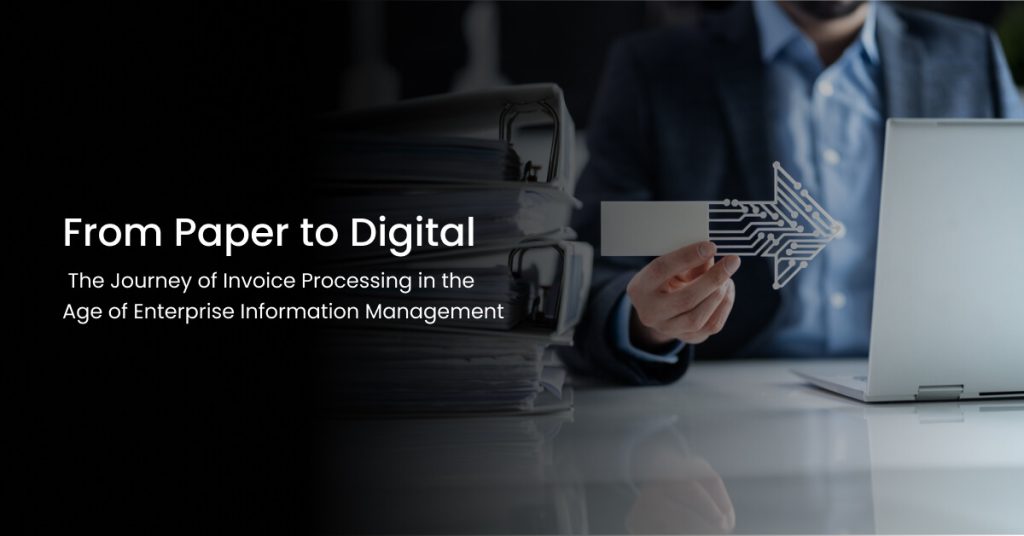
From inception to completion, invoice processing has been a journey of excessive paperwork, error-prone calculations, repetitive manual tasks, and other pointless operations. As an inevitable process in business management, the workflow of invoice processing can neither be overlooked nor ignored. The introduction of Enterprise Information Management (EIM) solutions via digital transformation seemed like a helping hand for organizations struggling with data capture, extraction, and document integration. From streamlining the invoice process to increasing the accuracy of data to enhancing workflow productivity, the digitization of invoice processing proved to be a beneficial add-on to driving organizational success.
As AI-based document management systems gain traction and significance, organizations can enjoy advantages such as streamlining document management. These systems automatically identify text in different document formats, extract relevant information, and categorize and organize documents accordingly.
However, according to the intelligence study by PYMTS, only 5% of midsized companies have a fully automated process. This reveals a lot about organizations’ hesitation towards digital-based invoice processing and the adoption rate of business process management, even in the digital age.
This blog will help you understand the difference between paperwork and a digital-based invoice processing system. It will also explore the digitalization journey of invoice processing, emphasizing the importance of an Enterprise Information Management system that your organization hesitates to adopt and utilize.
Enterprise Information Management: An Overview
Defined as a set of practices, tools and technologies, the EIM solution helps manage your organization’s information assets effectively and efficiently, ensuring the data and content are accurate, compliant, and secure. For invoice processing, the utilization of an EIM solution proves to offer a comprehensive advantage that assists in analyzing structured and unstructured data, extracting valuable information and securing driven insight by staying compliant with the latest rules and regulations. Before analyzing the assistance of an EIM for invoice processing, let’s discuss the benefits you can expect out of a digital-based invoice processing system.
Increased Efficiency: Automating invoice processing has resulted in eliminating manual tasks for data entry, data validation, approval routing and other monotonous tasks that require meticulous attention. It has also reduced bottlenecks and payment processing durations, leading to a faster invoice processing cycle.
Improved Accuracy: Extracting data from receipts of various formats, such as PDF, scanned image or paper-based documents, through automated data capture tools has increased the readability of text, including invoice numbers, dates, vendor details, and other key information. It also helped organizations verify invoice data against enforced validation rules, preventing the processing of inconsistent, incorrect and fraudulent invoices.
Enhance Supplier Relationships: Timely payment processing and transparent communication have been of major significance for organizations working to strengthen their relationship with vendors and suppliers. Thus, choosing to automate invoice processing has fostered positive business partnerships in the long run.
Flexible Invoice Processing: Handling large volumes of invoices is no longer a struggle as EIM-based invoice processing is scalable, allowing organizations to expand their business operations without any constraints.
Cost Savings: Reducing the reliance on manual tasks empowers organizations to eliminate errors, decrease paper usage, reduce operational inefficiencies and duration, track spending patterns and make financial decisions. This leads to an increase in optimal utilization of resources, thereby assisting organizations with cost-effective invoice processing management.
Thus, integrating EIM can be highly beneficial for organizations that are struggling to process invoice payments within a fixed time frame without affecting their bottom line.
How Enterprise Information Management Transforms Invoice Processing
In order to understand the working process of an enterprise information management solution, it is necessary to analyze the working procedure of an EIM for invoice processing.
Invoice Receipt: The account statement received from vendors or suppliers is collected in different formats, like PDF, email, supplier portals or written formats. This poses a challenging task for organizations to accurately decode details like invoice numbers, vendor details, payment amounts and other information to further process the invoice. This is where the assistance of EIM comes in the form of data capture and extraction.
- Utilizing tools and technologies like optical character recognition (OCR), intelligent data capture (IDC), and machine learning algorithms, the data is carefully read, captured and extracted.
- For example, if the invoice is in traditional mail format, the data is captured using OCR and then digitized to extract the invoice details.
- This way, the EIM ensures that no data goes unnoticed, for each format of invoice has certain tools and technologies to capture and extract information.
Data Validation and Verification: The next step in invoice processing is the verification of details against the pre-defined validation rules and criteria established in EIM per organization requirements and demands. The rules define the format, structure and content of data, which includes fields like invoice number, data, payment amount, and purchase order match, ensuring adherence to accuracy, completeness and compliance. Once the rules are defined, data validation checks takes place by
- Comparing the received invoice information against the pre-defined formats and accuracy.
- For example, validation checks verify vendor names with existing records in the system.
- The validation check process ensures that the received invoice adheres to internal invoice processing guidelines such as approval thresholds, coding requirements and payment terms.
- In cases of incorrect data or discrepancies, the EIM system triggers alerts or notifications, flagging the error to the designated user.
- Throughout the validation process, audit trails and documentation capture validation results and actions taken, providing a record of validation activities for compliance, reporting, and audit purposes.
- Thus, the utilization of EIM helps in verifying and validating the received invoice details, empowering organizations only with reliable data and information.
Approval workflow automation: Following the verification and validation process, the received and validated invoice moves for approval through pre-defined workflow automation that routes the invoice to the designated approver for reviewing, approving or rejecting the invoice via the approval hierarchy.
- The sequence of approval levels is pre-defined, ensuring the system automatically routes the validated invoice from the first or primary level of authorization.
- For example, the validated invoice may first require the approval of a manager later from the financial head and then finally it moves to the CFO.
- This way, every authorizer will be able to track the path of the invoice and also get notified about its status.
- Approvers can access the invoice information and may also comment if extra supporting details are needed to further process them.
- The approval process includes either approving the invoice, rejecting it or escalating the invoice for its inconsistent or inaccurate information.
- The escalation process leads to higher-level of approval based on pre-defined escalation rules.
- Thus, the EIM-based invoice processing streamlines the flow of approval, thereby reducing the payment cycle and ensuring rapid decision.
Integration with ERP systems: From here, the approved invoice gets integrated with the Enterprise Resource Planning (ERP) system, thereby streamlining financial processes, accurate accounting, effective expense management, and improved visibility into financial performance.
- Integration mechanisms, like Application Programming Interfaces (APIs) and other platforms, facilitate the seamless transfer of approved invoice data from the invoice processing system to the ERP system.
- The approved invoices are coded within the ERP system according to a predefined chart of accounts, expense categories, and project codes.
- Once the invoice gets integrated, it is time to update financial records that include accounts payable (AP) records, general ledger (GL) entries, and vendor balances.
- The invoice data now triggers the generation of payments that include due dates, payment methods and vendor information.
- This integration facilitates the accurate allocation of budgets to the appropriate budget codes, projects or cost centers defined in the ERP system.
- Thus, integration across the organizational ERP system ensures financial accuracy, preventing duplication and inconsistency of invoice data.
Payment processing and disbursement: One of the major advantages for businesses with the introduction of EIM is the ability to track payment processing. A large visibility into cash flow management helps organizations monitor timely payments and supports effective cash flow forecasting, budgeting, and financial planning, ensuring the relationship with the supplier or vendor is in a positive direction.
- As a part of ERP, the integrated payment processing system handles the generation of payments, which comprise payment scheduling, due dates and other criteria based on the approved invoice data.
- As preferred by vendors, the payment processing is done either through electronic payment funds, physical cheques or other methods of payment processing.
- After payments are generated, accounts payable (AP) records are reconciled within the ERP system to reflect the outgoing payments.
- As a final step, the status of each invoice is updated, marking as payment done, partially paid or kept on hold.
- The integrated payment processing system has a communication feature, letting vendors know about the payment transaction, remittance details and other details, thereby improving transparency.
- Thus, the integrated payment processing system enhances reporting and analysis capabilities within the ERP system, providing insights into payment trends, cash outflows, vendor payment performance, and financial metrics.
Document management and archiving: The EIM framework consists of a digital space that is dedicated for organizations to store, access and retrieve information, known as document management systems. As a centralized repository, the document management system provides a structured and organized environment for storing and accessing documents related to invoice processing.
- From invoices that have undergone validation to rejected and escalated ones, everything is available in the document management system.
- Additional or supporting documentation required or necessary for invoice processing is also stored here and made available to authorized users as per role-based access.
- Features like search functionalities, metadata tagging, and indexing mechanisms facilitate quick and efficient retrieval of invoice documents based on search criteria or filters such as invoice numbers, vendor names and other details.
- Thus, the process of storing, accessing and archiving documents related to invoice processing supports reporting and analysis of invoice processing activities, document statuses, payment trends, compliance metrics, and audit findings.
- Thus, the implementation of document management system within the framework of EIM empowers organizations to have direct access to invoices and other related documents, facilitating informed decision-making in invoice processing and financial operations.
Thus, the working model of invoice processing in Enterprise Information Management systems comes to a conclusion, stating that automating traditional invoice processing through business process management systems is the best investment companies can ever imagine. So why hesitate to adapt to the digital transformation that can help streamline your invoice processing, track real time payment processing and stay connected with suppliers and vendors?
SquareOne-Hyland’s Approach to Invoice Processing
Invoice processing is a crucial aspect of business operations, and efficient management of organizational assets is key. Partnering with digital transformation firms like SquareOne Technologies, a trusted partner of Hyland, can revolutionize your invoice processing into a seamless, paperless workflow. Hyland’s renowned accounts payable (AP) software solutions offer a fast and easy way to organize and streamline file-related processes, boosting productivity and efficiency. With Hyland OnBase AP document management software, your organization can:
- Organize and access information in real-time, supporting efficient invoice processing.
- Validate received invoices to prevent payment errors or duplicates.
- Ensure timely payments, meet deadlines, and stay compliant with invoice processing regulations.
The collaboration between SquareOne Technologies and Hyland offers a comprehensive invoice processing solution, documenting and auditing processes for future reference. Take advantage of this partnership to optimize your invoice processing, enhance productivity, and pave the way for a more efficient and successful business operation.
Conclusion
In closing, it is evident that the integration or implementation of an enterprise information management system has a lot to do not just for your organization but also for your employees. Why not consider it an option to enhance your business productivity and an automation tool to meet organizational goals? By leveraging advanced technologies in the EIM framework, like document management systems, enterprise content management, and expert guidance from SquareOne Technologies, organizations can achieve paperless, streamlined processes, ensuring accuracy, timeliness, and compliance with regulatory standards. Get started by scheduling a demo today!

















